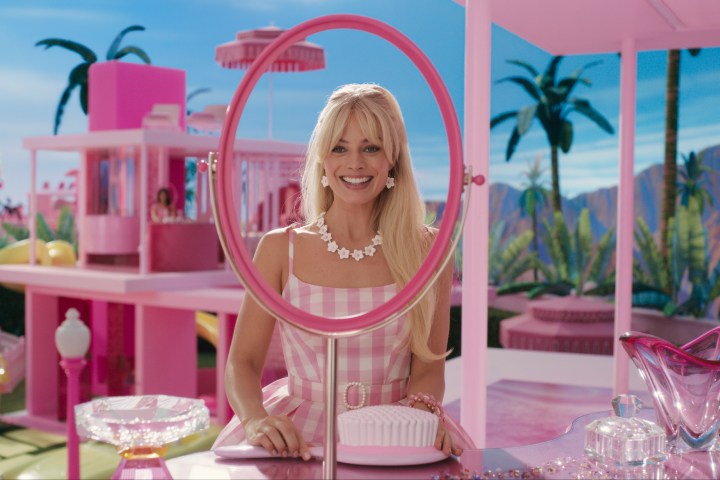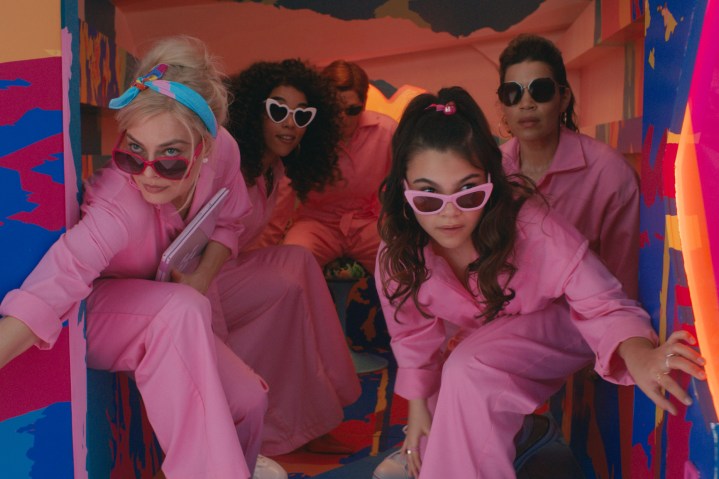
“Greta Gerwig's Barbie is a colorful and fun, but curiously flawed summer blockbuster.”
- Margot Robbie and Ryan Gosling's stunning lead performances
- Sarah Greenwood’s eye-catching production design
- Rodrigo Prieto’s colorful, sun-dappled cinematography
- An over-reliance on one-note supporting characters
- A script that can't stop apologizing and making fun of itself
- A third-act resolution that is too neat for its own good
There is Barbie and then there is Barbie. One is the most iconic doll ever made, the other is the movie of the summer. One is a vessel meant to inspire and profit off the dreams of little girls, the other is a movie meant to empower and profit off the thoughts and desires of women of all ages. One can be anything, and the other desperately wants to be everything. Both are products owned by the same toy empire, Mattel.
That may seem like too harsh a criticism to level against Barbie, the third film from director Greta Gerwig, whose previous efforts, 2017’s Lady Bird and 2019’s Little Women, rightfully earned her a place among the best American filmmakers working today. The problem is that Barbie *knows* it’s a product, and it feels bad about that. The film, which Gerwig co-wrote with her partner, Noah Baumbach, dedicates a not-insignificant portion of its energy to acknowledging and poking fun at all the problematic aspects of its own existence.
Underneath the film’s layers of artifice and pastel jubilance, there’s a constant sense of anxiety on the part of Gerwig, who seems torn between wanting to enjoy her first big-budget studio romp and feeling guilty over the corporate whims she’ll be satisfying if she does. This internal conflict is eternally present in Barbie, and it’s the thing that both makes the film interesting and also prevents it from reaching the heights it might have otherwise. The film is, in other words, just like the doll that inspired it: More than it needs to be, but less than it wants you to think it is.

Barbie’s fear of artistic fraudulence is, for the most part, absent from its enchanting first act. Following a clever Stanley Kubrick homage that was unfortunately spoiled in its first trailer, Barbie spends its opening 10 minutes introducing you to the vibrant, Wes Anderson-esque artificial home of its lead heroine, Stereotypical Barbie (Margot Robbie). The film follows her as she wakes up peacefully, showers without any water, drinks without ingesting anything, and floats down from the top of her windowless dreamhouse right into the driver’s seat of her perfect pink convertible.
The sequence is stunning to behold. From production designer Sarah Greenwood’s life-sized, plastic-looking sets to Robbie’s unparalleled commitment to fake-drinking and fake-brushing her hair, Barbie is immediately overflowing with enough clever details and visual ideas to convince you that you really have been transported to an alternate reality. For all of Barbie’s flaws, its world-building and sense of immersion leave little to be desired. Even the film’s soundtrack initially serves as both narrator and commentator, which only helps it look, sound, and feel, at first, like a truly kooky take on a 1950s dream ballet.
It’s in these opening minutes that Barbie introduces its other, alternate Barbies, all of whom hold different jobs and are played by everyone from Issa Rae, Hari Nef, and Alexandra Shipp to Emma Mackey and Dua Lipa. Also present in Barbieland is Ken (a magnificent Ryan Gosling), who spends his days hoping, as Helen Mirren’s omnipresent Narrator observes, that Robbie’s Barbie will look his way just once. In addition to Gosling’s Ken, there are, of course, other Kens played by Simu Liu, Kingsley Ben-Adir, Ncuti Gatwa, Scott Evans, and countless others. For most of its truncated first act, Barbie succeeds on the charisma of its star-studded cast, its wry sense of humor, and its own visual splendor. It’s easy, in fact, to imagine a version of Barbie that never even left Barbieland.

That might have been for the best, considering Barbie starts running into problems once it sends Robbie and Gosling’s oblivious dolls to The Real World (i.e. Los Angeles). Barbie, plagued by sudden thoughts of death, flat feet, and flashes of cellulite on her thighs, is advised by Weird Barbie (Kate McKinnon), a doll that was played with too roughly, that she’ll need to leave Barbieland if she wants things to go back to the way they were before. Thus, after agreeing to let Ken tag along, Robbie’s Barbie sets out on a mission to find the human girl responsible for her unexpected existential crisis.
Her journey brings her face-to-face Sasha (Ariana Greenblatt), a disenchanted teen girl, as well as her stressed-out mother, Gloria (America Ferrera), while Ken’s opens him up to the male wonders of the patriarchy. Fueled by his desire to finally get Barbie to reciprocate his romantic overtures, Ken decides to bring the patriarchy back to Barbieland with him, a decision that only sends Robbie’s depressed doll into an even greater existential crisis and proves to be the film’s undoing. Rather than actually exploring the ways in which society too often sidelines and tries to box women in, Barbie uses Ken’s misguided bid for glory as an excuse to monologue about the horrors of the patriarchy.
The scenes not only divert Barbie’s focus away from its endearing cinematic flourishes, but they also flatten its ideas down to the same empty platitudes that would belong better in a Mattel advertisement. Even worse, the film relies on Ferrera’s Gloria and Greenblatt’s Sasha, two of its least-fleshed-out characters, to explain the unfairness of the patriarchy to Robbie’s Barbie instead of allowing her to come to her conclusions on her own. These scenes, most of which feel like lesser versions of Florence Pugh’s fiery monologue from Gerwig’s Little Women, rob Barbie of its thematic richness and upset the balance between colorful spectacle and compelling fantasy it had previously established.

Narratively and thematically, Barbie has much in common with Peter Weir’s 1998 masterpiece, The Truman Show, which similarly centers around a character who dares to try and break free from the box he’s been put in. While Barbie borrows that film’s arc, though, it makes the mistake of moving its focus and narrative power too often away from its dissatisfied, unmoored heroine. In a somewhat tragic twist of fate, although Barbie is the rare studio blockbuster that feels like it was made by an actual flesh-and-blood artist, it could have benefitted from fewer actual human characters. It’s both a testament to the film and one of its fatal flaws that its most human characters just so happen to be made of plastic.
That’s partly because Robbie and Gosling are, in their respective roles, utterly mesmerizing. Over the years, Robbie has proven herself as one of the most courageous actresses working today. Here, she gives one of her biggest and most dynamic performances to date, bouncing from existential despair to bubbly warmth with the same elegance as the dancers who populate the background of the film’s few musical sequences. Her versatility is never more clear than when she stutters and runs away from a very-public humiliation on the part of Greenblatt’s Sasha only to cry out in a sob-choked blubber that she can’t be a fascist because she doesn’t even control the railways or the flow of commerce! You may, like Robbie, be tempted to both laugh and cry.

Opposite her, Gosling does so much as the heartsick, idiotic Ken, turning in a performance that combines the romantic yearning he displayed in Blue Valentine with the same slapstick physical comedy he brought to Shane Black’s The Nice Guys. Gosling and Robbie will, like Rodrigo Prieto’s cinematography and Sarah Greenwood’s production design, likely be met with much praise for their work in Barbie, and deservedly so. The humanity and artistry they bring to the film, alongside Gerwig’s often elegant direction, fill it with enough life to make it an easy recommendation.
It is also, undoubtedly, one of the strangest mixed bags of the year, a film that was destined to be packaged and sold in a box and yet is desperate to scream about how much it hates to be commodified. No one can get everything they want in the end, though, not even Barbie.
Barbie is now playing in theaters.
Editors' Recommendations
- Beyond Barbie: the 7 best Ryan Gosling performances, ranked
- Barbie’s ending, explained
- Conversations with A Killer: The Jeffrey Dahmer Tapes review: killer’s words yield little insight
- God’s Creatures review: an overly restrained Irish drama
- The Fabelmans review: an origin story of Steven Spielberg




